


























‘YOU DON’T




























‘YOU DON’T
“God has a plan for us all,” according to Chris Van Essen, a cattle feeder who farms between Carmel and Rock Valley.
He believes God’s plan for him is to raise his family on the farm and to feed cattle. “It gets in your blood to feed cattle. It’s the same for me as it was for my dad and my grandpa. When I went to Southeast Tech, I'd stay there Monday through Thursday, then get home as quickly as I could on Thursday nights to farm for the weekend. I’d go back up to Sioux Falls again on Sunday night after church.”
The cattle feeding gene flows from both sides of the family. His maternal grandfather, Herb Remmerde, played an important role helping both Chris and his father, Harold Van Essen, get started. Grandpa Remmerde is 89 and his ability to communicate is limited since he had a stroke last fall. “But Grandpa still likes to come out to our farm and my Uncle Lyle’s farm to ride by the feedlot. He just loves cattle. He loves seeing the new ones come in. Every six months when we turn the yard, you know he’s thinking, ‘Let's get some new ones and see what they do.’”
“Grandpa Remmerde loves that four generations are involved,” said Chris. Just as previous generations have helped him, he hopes some day that he and his wife, Whitney, can help their oldest son, Koston, 5, get started on the farm. It’s too
soon to tell what younger brother, Tate, is planning for his life.
“Koston is a little rebel. He loves the farm and wants to be outside constantly. He loves that Grandpa is here. If my dad and I are both using trucks to feed cattle, he’ll pick my dad because Grandpa’s a lot more fun. Koston also likes walking cattle, being in the yard. We’re starting to get him to help work the cattle, to keep them moving down the alley.” Harold said, “The way Koston’s going now, he’s going to
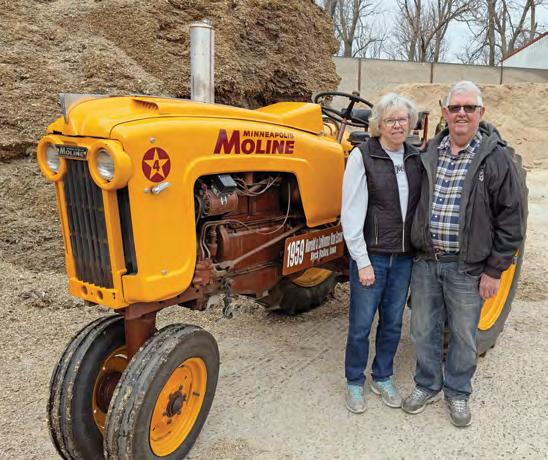

Tri-States Grain Conditioning systems will help you remotely monitor your grain. With our temperature cables, you will save on energy costs and improve your overall grain storage.

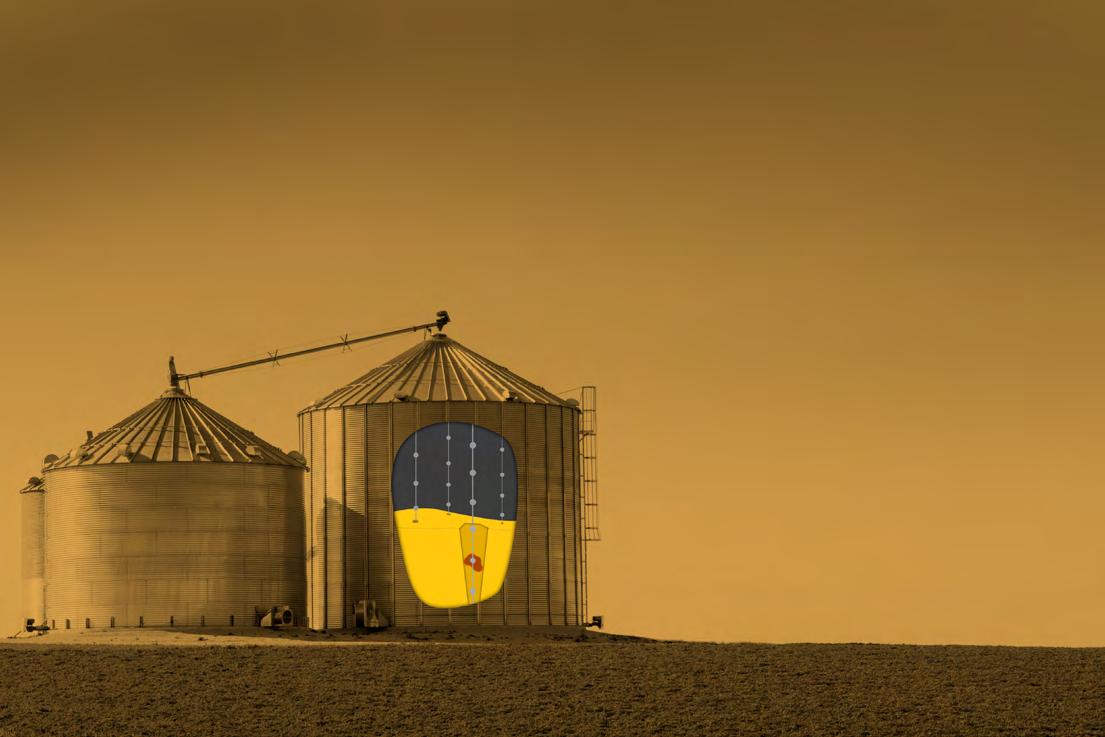


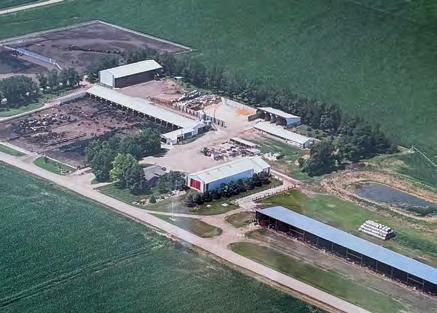
her down via Facebook. They got married about a year-and-a-half later in February 2018.
According to Chris, “I'm busy on the farm, but Whitney is busier in the house.” Tate is three and will start preschool soon. “He really loves riding in the back seat of the four-wheeler and going to check on everything outside. We’re an outdoors family. He’s really happy doing whatever.” A new baby is arriving this month.
Having Tate confirmed their decision for Whitney to be a stay-at-home mom. Before Tate was born, doctors identified he would have heart issues. With the high-risk pregnancy, Whitney was scheduled to be induced at Avera in Sioux Falls, but labor started unexpectedly. They set out for Sioux Falls, “going 90 miles an hour from Fairview to Canton.” After rumbling over the second set of train tracks in Canton, Whitney said, “I’m not going to make it.” So they diverted to Sanford’s Canton-Inwood Hospital – which no longer has a maternity department. Fortunately, there were
no major complications before he was transferred to the Avera NICU, where he was a patient for 30 days.
Tate was born with Down’s Syndrome and part of his aorta is wrapped around his esophagus and trachea, a rare condition. If the condition begins to constrict his breathing, it will involve a very serious surgery. Chris said it’s hard to understand why one child is fortunate to have great health and the other one has to face surgeries and other health issues. “You don’t know how God’s going to write your story, but he’s blessed us with Tate and he’s what we needed. There’s





been a lot of doctor’s appointments in the last three years, but everything is good. He's a lot of fun.”
Both boys like to help with their mom’s eight chickens. The hens are prolific producers and there’s plenty to share with family members. But Chris isn’t a big fan of the hens. “I went in the coop the other day and, all sudden, three of them flew at me and they were out the door. I thought, ‘What in the world? Now I’ve got to go catch chickens. I’ve got enough problems when the cattle get out.’”
The family also enjoys taking care of Golden Retriever puppies. Chris has raised purebred Golden Retrievers since he was about 13. “The puppies are good for the boys. It gives them a few chores to do,” he said. The family also parks its camper at the campground on the north side of Rock Valley every summer. It’s a good change of pace, yet it’s close enough for Chris to go home to do chores or for Whitney to take Tate home to meet the specialists from the Northwest Iowa Area Education
Agency. The depth of expertise, caring and involvement from the AEA teachers and specialists is appreciated. “They become almost as attached as we are.”
Harold Van Essen grew up on his parent’s farm near Inwood. Several months after high school graduation, he enlisted and served in Vietnam as part of the U.S. Naval Construction Battalion, better known as the Navy Seabees. During part of his 10 months in Vietnam, his unit worked on constructing a cement block plant to help provide homes for the Vietnamese. However, progress was slow because the plant kept getting blown up – most likely by Viet Cong, who, ironically, may have been among those helping the Seabees build the facility during the day.
He returned from the war to help on the family farm after his father injured his back. Then he worked in
construction. Harold and his wife, LaVonne, were married in February 1972 and started farming in 1977 on a bare 80 where Chris and Whitney live now. Harold built a house there in 1978, then started construction on cattle feeding facilities in 1979. He also had a farrow-to-finish hog operation on the home site, plus rented facilities from neighbors. He stopped farrowing in 1998 and owned finishing facilities until 2017. According to Harold, “Pigs were a good source of income for us for many years. They were a lot of work, but they were pretty good to us.” The hardest time on the farm was when the bubble burst in the swine market of 2015-16. It was time to step aside to see if Chris could successfully manage the growth of feeding cattle to finish. Harold and LaVonne moved into Sioux Center and Chris took over the farm site.
The couple’s oldest daughter, Lisa, works at Coop Gas & Oil in Rock Valley. Their oldest son, Todd, is in management at WalMart in Omaha. Their youngest daughter, Amy, is



controller at Grow Shop in Sioux Center. Chris is the youngest of the four, who are spaced far apart age-wise – Lisa is 19 years older than Chris. When the family isn’t farming, they like to camp north of Rock Valley, at Yankton and at the Newton Hills. Harold and LaVonne can now take the time to travel further afield to places such as Branson and North Carolina. However, Koston indicated his best times are spent in the tractor with Grandpa. On occasion, Harold and LaVonne will rent a big house in the Black Hills for the entire family to get together for four-wheelin’ and other fun.
After graduating from Rock Valley High School, Chris attended Southeast Technical College and received a degree in business administration. He began customfeeding cattle after graduating in 2012. Harold got out of cattle
feeding around 2016, but the corn he grows helps feed the herd belonging to Chris and Whitney, who also own cattle fed at a neighbor’s facility.
According to Chris, “I enjoy customfeeding because I’ve got good customers. Even when the markets do what they do, they're good to me.” He and his dad also haul feed for themselves and their neighbors, plus have cattle pots.
His plan is to continue to add to the cattle feeding capacity, but delayed expansion for now because of the rise in interest rates. The other limiting factor is the availability of land to spread manure – there are thousands of head being fed in the immediate vicinity. “I love what I do, but the risk side of it is always tough when you’re trying to feed a family and make a living and maybe get some new equipment here and there,” Chris concluded.
WE WORK FOR THE FUTURE OF AGRICULTURE AND THOSE WHO WANT TO BE A PART OF IT.













The future of agriculture is our future, too. That’s why we’re working with nearly 9,000 young and beginning producers –providing guidance, scholarships, youth programs and more. Contact your local office to learn more.
Agriculture Works Here.® FCSAmerica.com





At Premier, we know the importance of fast, reliable connections. That’s why when we install fiber optics, we don’t just bring the connection to your home. We will also bring fiber to your hog and dairy barns, shops, and accessory buildings. Get your home and operation up to speed with access to fiber and the best services from Premier Communications.




In the summer of 1948, northwest Iowa played host to the final time Babe Ruth ever set foot on a baseball field. Less than two months later, the Sultan of Swat was dead.
Fighting nasopharyngeal cancer for the previous two years and recovering from recent throat surgery, the former New York Yankee left Memorial Hospital in New York and traveled in June 1948 for an appearance at Sportsman Park in St. Louis, Missouri. From there he flew to Sioux City.
Bill Bryson of the Des Moines Register was at the Sioux City airport when Ruth arrived. He wrote: “It was a shock at first, seeing the gaunt shrunken giant emerge from the plane and walk with that shambling gait to the terminal building at the Sioux City airport … Now he’s a tired old man, a man who has been critically ill and who has undergone two delicate neck operations that has left his voice a coarse whisper.”
Bryson’s article continued: “Yet he retains that zest, that lust for life, which, with his home runs, made him the most widely known and the best loved individual in the ranks of working sportsmen. The dull glaze of his eyes would give way to a sparkle when anyone mentioned his home run records or, particularly, his early-day pitching that includes an unsurpassed streak of 29 consecutive World Series scoreless innings.”
Leaving the airport in Sioux City, the State Highway Patrol escorted

On the evening of June 22, 1948, approximately 4,000 people watched two American Legion junior baseball games at the fairgrounds. The games had been delayed by rain
from the afternoon. To dry the infield, 400 gallons of gasoline were burned. No one left after the games concluded … they held their ground waiting for the chance to see Babe Ruth. About 7:45 p.m., the Estherville American Legion Drum & Bugle Corps blared a welcome when the home run king entered the ballpark in an open car. The Sioux City


Journal reported: “People craned their necks. Many stood up to get the first possible glimpse. Youngsters clung to the railings … A roar went up as people finally caught the sitting figure. Shouts of ‘there he is,’ could be heard from many adults and children alike.”
Once The Great Bambino stepped out of his car, he was surrounded by youthful admirers. The Journal noted that the six- to eight-year-old kids swarming him were too young to have ever seen him hit any homeruns or even listened to his exploits on the radio; “Yet, somehow they felt they knew him.” The former slugger posed with all four of the teams playing in the makeshift tournament staged after his visit had been arranged. Teams from Hull, Salix, Peterson and Newell played.
The Sioux City Journal article from June 27, 1948, drew attention to two of the local boys who participated. The author noted how it must have been “doubly” exciting for the junior players. “For one there was Jim Wiese of the Hull junior team, whose two-run over-the-fence homer enabled his team to defeat Newell. The Babe, himself, could not have done better. And what a thrill it must have been for Milton Scholton of Boyden, a lefthander with the Hull club. Milton is a southpaw because he has only one hand. He lost the other several years ago. Despite his handicap he pitches – and wins, too.”
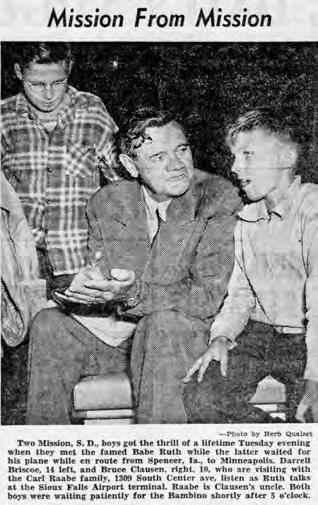


An article from the Society for American Baseball Research said Ruth was there to help promote the Junior American Legion Baseball program. Ford Motor Company was the sponsor of Ruth’s tour. Locally, the event was conceived and promoted by John Hart, owner of the local Ford dealership and also president of Spencer Baseball Inc. In addition, Hart was the manager of the Spencer semipro baseball club.
In 2012, eight baseballs autographed by Babe Ruth at the 1948 appearance sold for a combined $216,000. One ball alone commanded $77,000. The eight balls were consigned by the descendants of John Hart, who had stashed the baseballs in a safety deposit box.
The day after his appearance in Spencer, Ruth flew to Minneapolis, where he held a private press conference in which 11-year-old Johnny Ross was the only person who had the opportunity to ask questions. The Babe canceled his scheduled public appearance in Minneapolis. The next day he flew back to New York City and re-entered Memorial Hospital, where he died on August 16, 1948, thus making his short speech and photo session in Spencer his last public appearance. George Herman Ruth was only 53 when he died.
In 2011, the New York Times published two articles about film footage which was discovered in a cellar in Le Mars. The film shows Babe Ruth and Lou Gehrig at a gathering on October 18, 1927, at the home of John “Jiggs” Donohue, a widely-known commission firm owner at the Sioux City Stockyards. Earlier on that day in 1927, Ruth and Gehrig played in an exhibition game in Sioux City which Jiggs helped organize. The exhibition occurred a mere 10 days after the Yankees had swept the Pittsburgh Pirates in the World Series. This is a moment in time when Ruth and Gehrig were at the pinnacle of their powers – 1927 “was the season that Ruth hit 60 home runs, and Gehrig was the American League’s most valuable player.” Jiggs’ son, Phil Donohue, was nine years old in 1927. In the film clip, he is seen riding a pony. Soon after, Ruth dons Phil’s cowboy hat and takes a turn on the pony named Molly. Phil Donohue, who died in 2017, was the former owner of Rice Brothers Commission firm at the Sioux Falls Stockyards and one of the co-founders of Sioux Falls Regional Livestock.
The Donohue family also has the film footage and it’s not certain if theirs is the original or if the reel from Le Mars now owned by a “pop culture archeologist” is the original. The New York Times said the film was shot by Dudley C. Scott, who owned two movie theatres and a movie camera manufacturing company in Le Mars. Footage from the Donohue-owned reel was used in two baseball documentaries on HBO.



 BY JOEL SCHWADER
BY JOEL SCHWADER
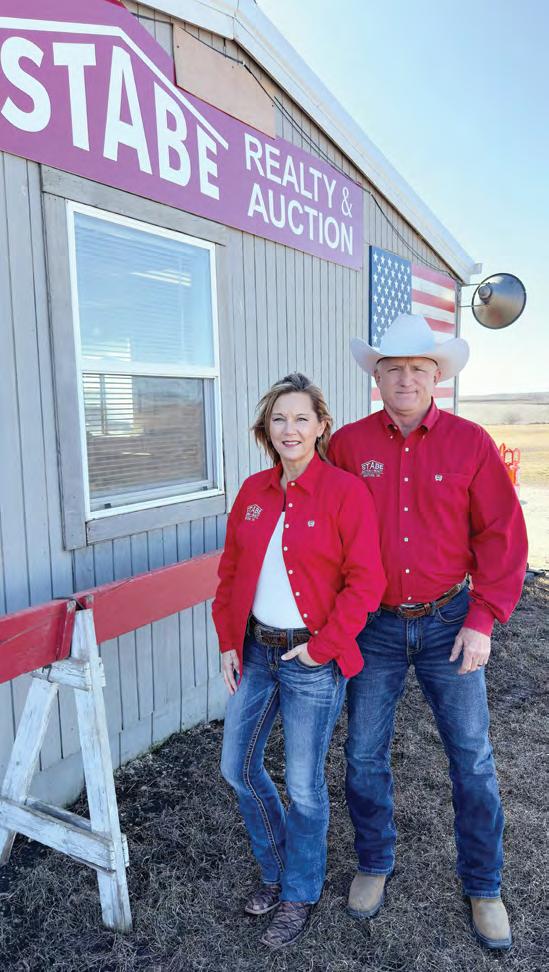
Randy Stabe’s first experience auctioneering was when his father flipped him out of the frying pan and into the fire.
“Dad always volunteered to do local charity auctions. The Hinton school was having its pie auction just a few days after I got back from auction school,” Randy remembered. “Dad was auctioning off the pies and most of them were sold. When he got down to the last four or five, he said, ‘I'm going to let Randy sell these last ones.’ He didn't give me any warning. I wasn't prepared for it, but I made my way through. Of course, it was my hometown, so everybody was real good about it.”
His father, the late Vernon Stabe, attended auctioneer’s school in 1958, the year Randy was born. Randy became an auctioneer in 1976. “I was fortunate enough to watch how Dad did it. He was a great mentor. He always had a good reputation and was as honest as anybody in the country.”
Randy met his wife, Shelley, in January 2016 at a political event, where she was a volunteer directing guests. Randy said, “I’d been single for a few years and I swore I was going to stay single. Then, at this event at the Orpheum, here was a pretty lady
in a red dress and cowboy boots. She caught my eye.” With the help of some computer-savvy people, he found her on Facebook and eventually they agreed to meet for coffee. It turned out she grew up as a farm girl in O’Brien County and is a graduate of Paullina High School. Her father still lives on the former dairy farm located east of Alton.
According to Randy, “Little by little, we got to know each other. We complement each other as far as our work ethic.” The couple married in 2017. She’s become active in Stabe Auction & Realty; and he’s there on occasion to help in her residential paint business. Shelley also spends time on a small organic garlic production enterprise and volunteering for political candidates.
Randy farmed with his dad and he continues to grow corn and soybeans today on the ground his great grandparents purchased from the railroad in 1884. Shelley’s favorite job is running the grain cart and she helps by running for parts and getting Randy fed.
Randy and Vernon had a cow-calf herd and a farrow-to-finish hog
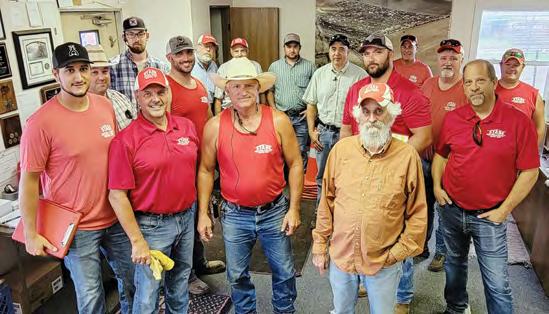
operation. However, as the auction business grew, the livestock went by the wayside. “I’ve always been a hands-on guy. I love farming, so I stayed here to help Dad. I also worked in the cattle alley at the Sioux City Stockyards. I'd get up about 4:30 in the morning and go down there and work till about 1:00. After we got the cattle weighed up, I’d go home and jump in the tractor or combine and work until 10 or 11 at night. I’d get three or four hours of sleep and do it all over again.”
To meet the quiet man in the cowboy hat, a person might not

guess Randy’s life had a wilder side. “In my younger years, people told me I was a cat with nine lives. I wrecked a couple of cars where I got thrown out the window but walked away.” He used to do calf roping and team roping in the rodeo, bred horses and broke colts, and helped others in the spring by roping sick calves in the pasture. “You get in a strange pasture and you’re concentrating on the calf, then here’s a little ditch or washout. I took some tumbles where I was lucky I wasn’t hurt too bad.”
His most life-threatening experience happened on a tractor



Combining the strength of a large company with the agility of a small company.

Grain Sales | Agronomy Services Livestock Feed
Remsen Farmers Cooperative provides solutions and dependability local growers can rely on!
712-786-1134
www.remsencoop.com
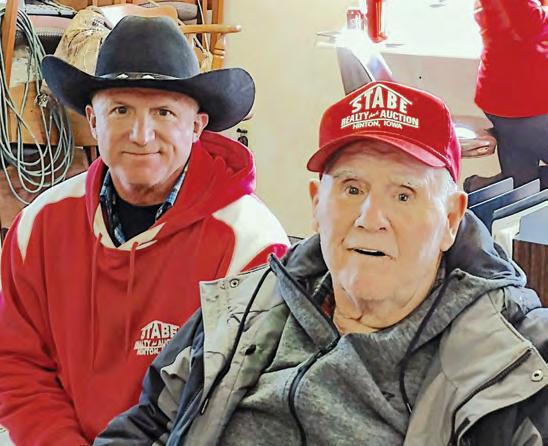
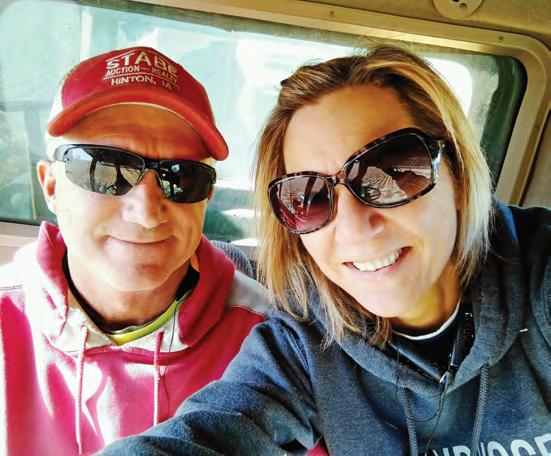
seat rather than in a saddle. After unloading ear corn, 23-year-old Randy was returning to the field, pulling two empty wagons behind a Massey tractor with no cab. As he approached a bridge on a gravel road, the steering went out, leaving him with no control. The front-end loader broke through a railing on the bridge. That’s the last thing he remembers until he awoke in the creek bed pinned down by the tractor. The steering wheel was on his chest, the tractor hood was on his legs and his head was underneath the fender. “I figured I'd probably be dead before too long.”
After 30-45 minutes, a neighbor lady saw the wagons on the road and came to investigate. Finding him still alive, she went to call 911 and get help. He didn’t want her to leave: “I didn’t want to die alone.” After what seemed like forever, he heard his dad’s pickup. “I'll never forget, he opened the pickup door and said, ‘Oh my God, Randy, what did you do now?’ I heard that as plain as day – and it's funny now when you go back and think about it.”
Soon neighbors arrived. It took a long time in the soft creek bed to do the blocking necessary to lift the tractor without crushing him further. When they were ready to start lifting, they asked if he wanted to wait until his mom got there – because they didn’t know if it would be his end when the pressure came off. “I said, ‘Just tell her I love her.’”
Amazingly, Randy didn’t have any broken bones and the circulation returned to his legs in about eight days. He was in the St. Luke’s burn unit for three-and-a-half weeks with second and third degree burns on his face and in his ear from battery acid and hot hydraulic oil. He had skin grafts done, but the scars have faded. Still vivid though is his appreciation for having survived.

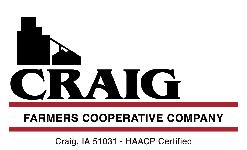

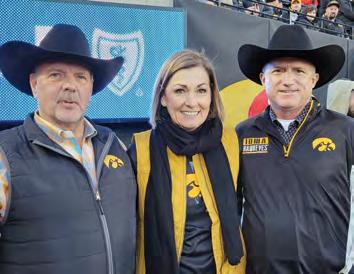
Randy Stabe (right) with Gov. Kim Reynolds and his long-time friend, Clint Vos. Randy and Clint received the prestigious Heroes Award during the 2022 Iowa-Nebraska football game. In a quiet fashion, Randy annually conducts auctions for as many as three dozen charitable organizations such as: Alzheimer’s Association, St. Florian Burn Camp, Boys and Girls Club, Camp High Hopes, Pheasants Forever and the Plymouth County Fair premium livestock sale. Clint manages the GCC plant in Sioux City and is a trained auctioneer. He volunteers side-by-side with Randy on the charitable fundraising auctions, plus helps on other auctions throughout the year.
The family’s former cow pasture is the long-time home of the Stabe Auction spring and fall consignment sales. First held in 1978, the sale has grown every year. “Now we run three auction rings all day with two auctioneers in each ring. It's really grown into a good deal for the community.” This year’s sale is Saturday, April 6th beginning at 9:30 a.m. Most of the machinery and tools on the sale are ag-related.
Shelley likes to market the Stabe Consignment Sale as the “official start of spring in Plymouth County.” Typically, there are over 1,000 bidding numbers. Much like Randy’s experience, Shelley’s introduction to the auction world was a baptism by fire. “Ever since I met Randy, I jumped right in to help and I've never stopped,” she said. Since then, she’s converted the company to computer-based bookkeeping and records.
Preparing for the sale is a tall task. According to Shelley, “Randy lives out here for about three weeks – about two weeks before and then a week after. When I watch him put together the consignment sales, it's very easy to admire him. Few people know what it takes to organize a big consignment sale and I can’t imagine anyone who could do it better than him.”
When sale day arrives, there’s a tremendous outpouring of help. Siblings, sons, daughters, nephews, and friends all have important roles to play on the big day. “I’m very fortunate to have a lot of people who I can rely on,” he said.
In addition, Randy’s business includes real estate appraisals and sales; and auctions of land, estates, farm and construction machinery and household items. “I always say I sell the earth and everything on it.” Shelley has a real estate license, plus organizes the office help for the consignment sales, handles marketing via the web/social media; and often is a clerk or cashier at auctions.
Randy has six children and all try to help on consignment day. His oldest sons help at the spring sale, plus other auctions as their schedule allows. Ben manages the Sioux City Target store and twin Bryce manages Graham Tire in Sioux City. Brittany is a nursing student who will graduate in May and is expecting a baby.
Kaitlyn is taking classes at Briar Cliff University. Chase is a junior at the University of Iowa. Kaylee is a freshman at South Dakota

State University, where she’s also a member of the Barrell Racing Team, following in her dad’s rodeo footsteps.
Shelley’s son, Jordan Everson, is a building contractor based in Orange City. He also serves in the
Iowa National Guard. Her daughter, Deanna Everson, works at a daycare in Huxley, Iowa, and lives in Madrid, Iowa. Altogether, Randy and Shelley have 11 grandchildren with one on the way.

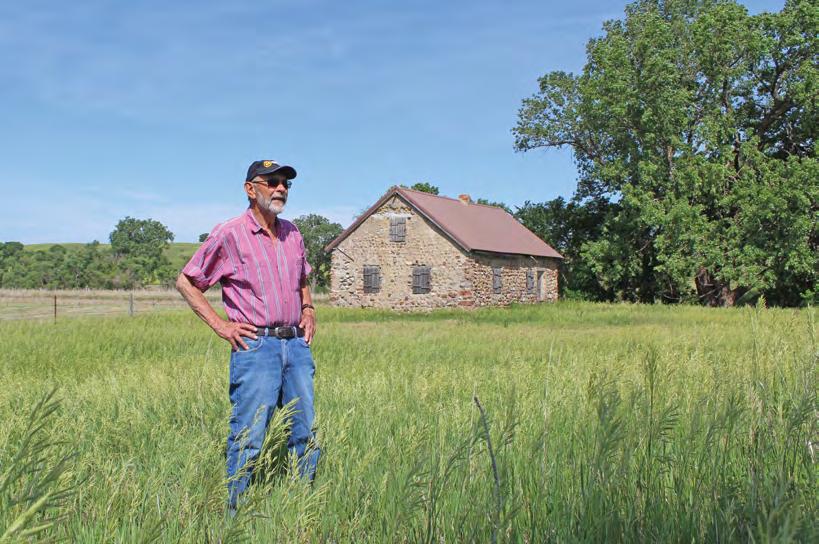
Hidden in the rolling hills of Hutchinson County, South Dakota, stands a stone house built by a German immigrant craftsman more than 130 years ago. No road or even path takes a person to this concealed treasure of yesteryear.
While the locals will recognize his face, the property owner wants to protect the landmark; therefore he’d rather just use his first name (Owen) in this story. Owen’s father purchased the stone house and the surrounding property in the 1940s and his uncle was the last to take residence here some 70+ years ago.
Gottlieb Stern was one of the early pioneers in the area and the builder of the stone-and-sod house. A master stone mason and carpenter, Gottlieb first took shelter in a dugout before building a modest stone house. The impression of the dugout is still there next to
remnants of the foundation of the first stone house. The larger stone house was constructed around 1885.
“I know there’s a few sod houses still around, but I think this might be the last stone house in the area,” Owen said.
In 1984, two graduate students from the University of South Dakota carefully examined and blueprinted the house. Owen said, “The house was in pretty rough shape at that time. It still had wood shingles, which the raccoons tore
off so they could get inside. The holes in the roof ruined one room inside completely.”
To try to protect the stonework and the interior, he and his son put a tin roof on the structure in 1999. “With the tin roof on, we thought we had it made. But there were trees hanging over the house. And the raccoons would climb the trees and jump from the branches onto the roof of the house and they’d get in through the chimney. So we cut the trees down around the house. Then I put shutters on the windows, too. When I put those shutters on, there were no two windows that measured the same. They had the hole in the stones and just made the window to fit the hole.”
The University of South Dakota graduate students described it as a “an extremely well-built structure” with beautiful use of dressed stone. The walls of fieldstone and clay mortar are approximately 34 inches thick and extend 14 feet 6 inches in height. Between this line and the peak, the wall is puddled clay. The total height is 22 feet 7



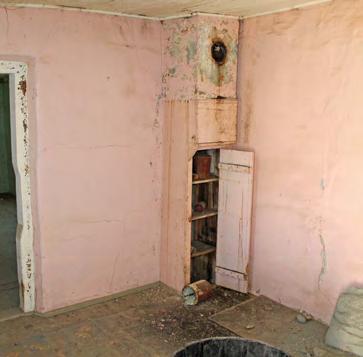
inches. Owen said the thick walls were a blessing and a curse for retaining heat in the winter. Back in the 1940s, when his uncle would leave for a month or two to do chores for someone in the winter, he said “it would take forever to get the place warm” once he returned. Once the rooms were warm, the thick walls did hold in the heat.
The USD report said, “Probably the most striking characteristic within the house is the elaborate use of
timbers in the construction of the roof.” In addition to 15 common rafters measuring 2 inches by 4 inches, the roof is supported by a squared 4-inch by 4-inch ridge pole. Six extra support beams, four measuring 4 x 4 inches and two measuring 4 x 6 inches, as well as 4 x 6-inch vertical boards similar to knee braces, are also used.
The ridge pole, which is exposed in both gable ends, is made of three separate beams joined by a scarf

joint and wooden peg. Another set of the three support beams is notched in a crossing pattern with a mortise and tenon joint. A wooden peg secures them directly below the ridge pole. The USD grad students speculated, “The explanation for such an extensive roof system is not clear, but the need to secure the massive walls may be one possibility. Another may be the exhibition of skill by the builder.”










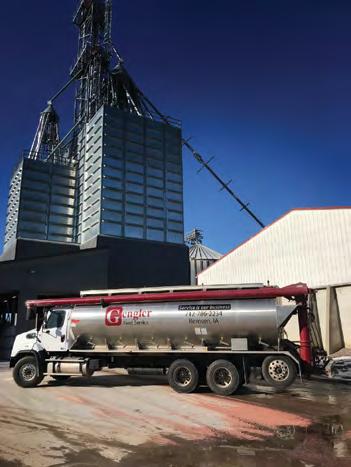

While stone was plentiful on the hillsides of the property in 1885 (and still is today, of course), there were no trees there back then. Consequently, the roof beams were transported by steamboat to Yankton and then hauled over land to the site.
The interior of the house is divided into four rooms of approximately equal size. The southwest room has a traditional ladder stair to the loft and a trap door over the root cellar (the trap door was permanently closed in 1948). In the west room, the light-blue walls have a continuous stenciled frieze, a common decorative style at the time of construction.
The house has a half cellar which measures 12 x 17 feet. Northwest of the house, Gottlieb built a stone corral measuring 166 x 110 feet

for his livestock. Parts of the stone fence are still visible.
Owen and his son have continued their vigil of preservation of the house, which is a labor intensive effort. In addition to the roof added in 1999, they’ve reinforced
the structure by applying concrete to the original mud mortar. Five years ago, they spent a lot of time repairing one of the corners which was falling into disrepair. “It’s a heck of a job to try to get concrete to stick to the mud,” Owen said.




After the second generation of Sterns departed and before Owen’s father purchased the property, the isolated house proved to be a refuge for victims of the Great Depression and the Dust Bowl. “I don’t know how many people lived
here in the ‘30s,” Owen said. “But most of them were people who lost their farm and had no place to go. They moved in here for nothing. Back then, when you were broke, you were really in trouble. There was no government help.”
In fact, Owen’s uncle moved there because he’d lost his health and

couldn’t get a job. “When my uncle lived here, they’d try to stock up on as much food as they could in the fall.” Most of the time in the winter they had to leave their car at a neighbor’s farm quite some distance away because cars of the day couldn’t make it through the snow to the remote location. There has never been electricity or telephone lines run to the hoswuse.
In addition to preserving the stone-and-sod house, the family marked out the borders of a nearby cemetery on a ridge which had been forgotten by everyone except Owen and his family. He’s also held on to his ability to speak German, “but not that well anymore because I’ve got no one to speak it with. When I started grade school, I had to quickly learn English before I could go. Lucky for me, the teacher also spoke German, so if I got stuck she’d help me out.”

Shallow Creek Consulting is looking for hog barns for swine operations that we work with and manage. If your barn is coming open or you are looking for a change, give us a call and see what we have to offer.
Shallow





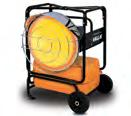
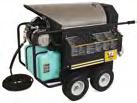
AMMONIA - the release of nitrogen equal to about 40 units per acre from building losses and field application.
HYDROGEN SULFIDE - one-third the loss of sulfur from manure.
METHANE - the loss of carbon in high PH and anaerobic conditions.
ONE A.C. PIT PUCK will control the gasses in 2,000 gallons of liquid manure for $3.50
It is the gasses that destroy the steel and concrete, and cause explosions in your buildings!! Gasses also cause coughing in hogs and workers!
QUESTIONS? CALL:
Verlyn Sneller: 712-441-6359 | Dennis Von Arb: 712-540-2439
DISTRIBUTORS:
NuForce Kevin: 712-441-2334
Feed Tech Inc. Verlyn: 712-441-6359

Van Voorst Equipment
Shawn: 712-449-6629


Von Arb Ag
Dennis: 712-540-2439



INGREDIENTS:
1 lb turkey breakfast sausage, hot or mild
1/2 c chopped onions
1 (15-oz) can diced tomatoes with green chilies, undrained
1 (8-oz) can tomato sauce
1 (15-oz) can small red beans, drained and rinsed
2 c frozen Southwestern corn (with bell peppers and onions)
2 c cold water
1 tsp chili powder
1 tsp ground cumin
1/2 tsp dried oregano leaves
1/8 tsp garlic powder
1/2 tsp black pepper
1 c shredded Mexican cheese blend
1 to 2 oz tortilla chips, crushed
DIRECTIONS:
1. In a large heavy soup kettle or Dutch oven over medium heat, cook turkey sausage, breaking sausage into small pieces. Cook until no longer pink.
2. Remove from pan and drain sausage on clean paper towels.

3. Drain all but 1/2 to 1 teaspoon pan drippings from pan.
4. Add onions and sauté just until soft.
5. Stir in cooked sausage, diced tomatoes with chilies, tomato sauce, beans, corn, cold water, seasonings, herbs and black pepper.
6. Cover and gently simmer for 30 minutes, stirring occasionally.
7. Portion each serving in a soup bowl and top with 2 tablespoons shredded cheese and 1 tablespoon crushed chips.
Congressman Randy Feenstra TALKS LIKE A CONSERVATIVE, BUT HE DOESN’T VOTE LIKE ONE.
Feenstra supports eminent domain against landowners with no public benefit -- and only benefits his large donors, which include summit carbon solutions and its founder bruce rastetter.
feenstra votes to fund the biden administration’s wasteful policies, which harm iowans and our agriculture industry.
feenstra voted against a measure to close the unconstitutional federal department of education.
feenstra routinely votes to raise the federal debt ceiling and send billions of foreign aid overseas, while our middle class struggles with rising inflation.
Kevin Virgil grew up on a farm in O’Brien County and served his country as a US Army Ranger and CIA case officer. He is a warrior and an entrepreneur who will uphold his oath to the Constitution.
Can your current Congressman say that?
Western Iowa needs a true conservative in Congress!
Say NO to Feenstra on June 4
Meet Kevin for yourself. Check out events on the website at www.virgilforcongress.com







